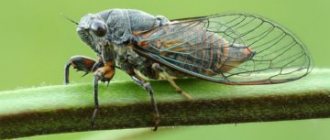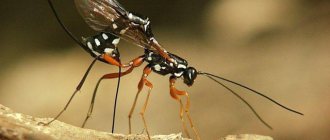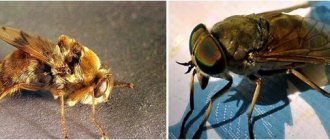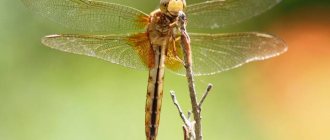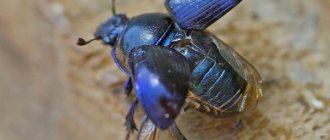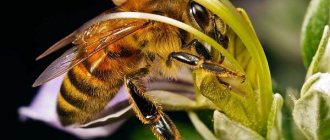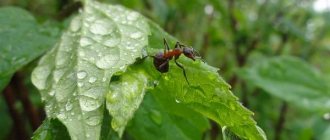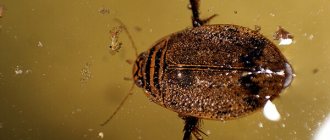There are a large number of different insects in the world. Some of them can be both dangerous and safe for humans. The second group includes the cicada insect. It has a long life cycle and sings unusually. In Ancient Greece it was believed that this fly has no blood, but feeds exclusively on dew.
Description and features
Most cicadas have a body length of no more than 36 mm, and if measured with folded wings, then about 50 mm. The antennae with a flagellum are most often quite short. The lower surface of the front femurs is decorated with two large teeth.
On the head of song cicadas, between the large compound eyes, there are three more simple eyes. The proboscis is long and can easily cover the length of the entire chest.
Males have a well-developed apparatus for making very loud sounds. During the mating season, which can last several weeks, the volume of their singing can be comparable to the noise of a train passing on the subway and is expressed at 100-120 dB, which allows us to call them the loudest insects on our planet. The color of common cicadas is predominantly black or gray, the head and front back are decorated with intricate yellow patterns.
The larvae are usually no larger than 5 mm in size and do not resemble their parents. They have powerful front paws, which they use to dig into the ground to protect themselves from the winter and undergo further development into a nymph. They are distinguished by a light body, but the specific color depends on the species and habitat.
The winter cicada is never an adult - due to the fact that they do not live long, individuals that survive metamorphosis die even before the first snows. All that remains are the larvae, burrowing deep into the ground, and the nymphs, waiting for warm days to begin pupation.
Therefore, further we will talk only about the larvae. The habitat of the common cicada is considered to be the Mediterranean and the Crimean Peninsula. These insects are also common in the Caucasus region and Transcaucasia.
Fighting methods
- Folk methods of struggle
- Tar soap solution. Dissolve 100–200 grams of soap in 10 liters of warm water and treat the plants with this solution.
- Garlic - tobacco mixture.
- Planting garlic and onions next to the plants.
- Special traps - flashlights, vacuum blowers.
- Chemical control methods
To combat cicadas, you can use special chemicals that are sprayed on plants. Attention, these products must be used in accordance with the instructions and all precautions must be observed:
- "Fastak"
- "Akarin"
- "Karate 050 EU"
- "Fitoverm"
Kinds
The most impressive of all cicadas can be called the Royal (Potponia imperatoria), which is considered the largest on the planet. Its body length is 65 mm, and its wingspan is 217 mm. These giants are found in peninsular Malaysia and Singapore.
The coloring of the royal creatures resembles the bark of a tree, on which the cicada insect spends most of its terrestrial life. Transparent wings also do not spoil the camouflage, so it is really difficult to notice such a large creature.
Singing cicadas prefer regions with hot and humid climates. Therefore, about 1,500 species can be found in the tropics. In Europe, 18 species of these insects are widespread. Some of them are very numerous. Cicadas are permanent residents not only of Eurasia, Indonesia, but also other places; accordingly, their species differ:
1. Green cicada . It is found everywhere in China, Kazakhstan, the USA, most regions of the Russian Federation and many countries of Western Europe. They live mainly in swampy areas, in flooded or wet meadows, where a lot of lush grasses and sedges grow. The wings are greenish, the body is yellowish, and the abdomen is blue-black. Considered a pest. Cereals are especially affected by green cicadas.
2. White cicada - metalkafa or citrus. Grayish in color with a whitish tint, length no more than 9 mm, the insect, together with its wings, has an elongated shape. It looks a little like a drop, even like a small moth.
It's hard to believe that the fluffy growths that appear on plants in mid-spring are living metalcaf larvae that cause damage to agricultural plants.
3. Buffalo cicada or humpback cicada . Above their head is a peculiar growth that gives this species its name. It parasitizes green grape stems, in which it hides eggs, after cutting the shoot bark with the ovipositor, which causes the damaged stems to die.
4. Mountain cicada . Distributed in China, the USA, Turkey, Palestine, and also found in large quantities in the Far East and Southern Siberia. Its body is about 2.5 cm long, very dark, almost black, its wings are thin and transparent.
5. Ash cicada . It is half the size of an ordinary one. Entomologists classify it as a member of the songbird family. The name comes from the manna ash tree, whose branches insects chose to lay eggs. The body dimensions of individual specimens reach 28 mm, the wingspan is up to 70 mm.
On the thick, almost transparent abdomen, reddish segments and small hairs are clearly visible. There are brown dots on the veins and surfaces of the wings. They feed only on sap, which is extracted from plants and young branches of bushes. They prefer olives, eucalyptus, and grapes.
Unique periodic cicadas (Magicicada) from North America, whose life cycle is 13 and 17 years, are also classified as songbirds. They differ in that they degenerate en masse into adults. The insects are sometimes given a unique nickname - “seventeen-year-old locust”. But they have nothing to do with locusts.
Cicadas live on every continent except Antarctica
The superfamily Cicadoidea is divided into two subfamilies: the Tettigarctidae (also known as hairy cicadas), which are largely extinct except for two extant species, which are found in southern Australia and Tasmania, and the Cicadidae, or song cicadas, which can be found on all continents except Antarctica. They thrive in warm environments, especially the tropics, making Latin America, Australia, Southeast Asia, the Western Pacific and South Africa hotspots.
There are more than 170 described species in the United States and Canada, and the United States alone is home to 15 “broods” (groups of cicadas with different life cycles) ().
Lifestyle and habitat
Adult cicadas emerge from the ground in summer and cut the bark of young branches with a serrated ovipositor. Then they hide the oviposition under it. The hatched larvae fall to the ground, bite into its thickness, and already at a depth of more than a meter continue their development.
They bite through the roots of trees and feed on their sap. The larvae have a light, opaque body, first white and later buffy, with long antennae and powerful forelegs. They spend 2 or 4 years in their burrow, almost until they grow up, and only just before their transformation do they rise to the surface.
The cicada always burrows deeper in winter and hibernates. At this time, the larva develops and gradually turns into a nymph, and after the soil has sufficiently warmed up, they emerge and begin to dig small chambers for pupation.
Most people can hear the sounds that cicadas make at a distance of up to 900 m, as the power of their love trills reaches up to 120 dB. The males “sing” the loudest - in this way they call their future partners and make the right impression on them.
Sometimes the sound of a cicada begins to resemble not clicks or chirping, but the screeching sound of a circular saw. In order to crack loudly, they use certain muscles, with the help of which they act on the cymbals - two membranes (tymbal organs).
The loud sound vibrations that appear during this process are amplified by a special camera. She also works in the same rhythm with them. looks great in the photo , where you can see its structure in detail.
Females also know how to make sounds, but they sing rarely and very quietly, sometimes even so much so that the sounds are indistinguishable to the human ear. Sometimes cicadas gather in large groups and then the noise made by the insects does not allow predators who want to try something tasty to approach them.
However, it is difficult to catch cicadas because they can fly. In damp or cloudy weather, cicadas are inactive and especially shy. In warm sunny times they are quite active.
What interesting facts
Many interesting facts are associated with cyclides. In China, the insect is a symbol of longevity and eternal youth. Previously, it was customary there to place a representative in the mouth of the deceased before burial. This will ensure an eternal afterlife.
The insect is a symbol of resurrection. This is due to the emergence of an adult from the ground after a long stay in the larval stage. Nowadays, a butterfly is often given to newlyweds as a sign of fertility and prolongation of the family.
Many people make amulets and decorations in the form of cicadas
The insect symbolizes prosperity and good luck. Using insect amulets helps restore vital energy. It is also a kind of amulet against unwanted events and enemies. Cicada jewelry is often worn by politicians to prevent various scandals of intrigue, as well as protection from enemies.
In China, the cicada was often kept in a beautiful cage to constantly enjoy the insect's song. Only wealthy people could afford such a pet. The sound emitted by 5 representatives cannot withstand human eardrums.
Nutrition
The feeding peculiarity of cicadas is such that in many countries they are considered parasitic insects. Vineyards, garden plants and trees suffer from their invasions. Adult cicadas damage stems, branches, and leaves with their proboscis, extracting the desired juice from them.
Having been saturated, they are removed, and life-giving moisture continues to flow from the “wound,” gradually turning into manna - a sticky, sweetish substance (medicinal resin). Cicada larvae living in the soil damage the roots as they suck out the liquid from them. The degree of their danger to agricultural crops has not yet been established.
Because of their powerful mouthparts, cicadas can “suck out” and damage even plant tissue located deep inside. As a result, after such feeding, crops may die. In agricultural areas where there are many cicadas, farmers often notice a drop in yield. Both larvae and adults can be dangerous.
Insect danger: damage from cicadas
These insects do not pose a direct threat to humans . Cicadas are exclusively herbivorous. But agricultural plantings can suffer from the activity of cicadas and their larvae. Although in most cases these arthropods are not considered harmful pests of crop production, there are still exceptions.
First of all, it is worth noting that cicadas lay their eggs in plant tissue . To do this, they use a sharp ovipositor to make cuts on the surface of the branches. If there are many such “wounds”, then the plant may suffer noticeably . And not only from loss of juice. And also from the attack of viruses, bacteria and other microscopic parasites that begin to actively multiply at the site of the incision.
In Australia, there are leafhoppers that are pests of sugar cane . Some Japanese species suck the juices out of rice , significantly reducing its yield. Others are not so picky about plants and feed on any crops and trees .
In addition, it is worth noting some indirect harm from cicadas. Thus, bees are very fond of the excess sugary secretions formed when they feed on juices. They collect it. However , the resulting honey becomes poisonous .
***
We haven't told you everything about these interesting insects. However, you probably already have an idea about cicadas. They are very diverse and arouse interest not only among scientists, but also among ordinary people. In eastern countries, lovers of their singing sometimes breed cicadas as domestic song animals . For those who just want to listen to the sounds of cicadas in nature, we advise you to go to the Krasnodar Territory, Crimea or the Black Sea coast in the summer)
Reproduction and lifespan
Males, when calling their mates, most often chirp during the hottest time of the day. To do this, they require a lot of energy, which they replenish directly from solar heat. But some species, recently, are trying not to attract predators and start their serenades in the evening, at dusk.
Males try to choose shady places even during the day. Platypleura cicadas have especially adapted to this; they have mastered thermoregulation and can warm themselves by squeezing the muscles with which they fly.
To attract lovely ladies, male cicadas in the southern United States begin to make sounds somewhat reminiscent of the whistle of a steam locomotive. Cicada reproduction is unusual for many species. As soon as the insect fertilizes the female, it dies immediately.
But females still have to lay eggs. They can have from 400 to 900 eggs in one oviposition. In addition to the bark and stems, eggs can be neatly hidden in the root parts of plants, often in winter crops and carrion.
On average, adult insects do not have a long lifespan; they are allowed to stay at the festival for no more than 3 or 4 weeks. There is only enough time to find a partner and lay eggs, which will then be hidden by the females under the bark, in the petioles of leaves, and in the green stems of plants.
They are shiny, white at first, then darken. The egg is approximately 2.5 mm long and 0.5 mm wide. After 30–40 days, larvae will begin to emerge.
Descriptions of the life cycles of cicadas of different species are extremely interesting to entomologists and simply nature lovers. The larvae of unique periodic cicadas remain underground for many years, the number of which corresponds to the initial series of prime numbers - 1, 3, 5, 7 and so on.
It is known that such a larva lives no more than 17 years. However, this period is also considered a record for insects. Then, anticipating metamorphosis, the future cicada (nymph) gets out of its cozy little world and changes. The mountain cicada lives no more than 2 years, the common cicada lives twice as long - 4 years.
Structure of the vocal apparatus
The vocal apparatus has three cavities: two lateral and one median. Inside the median there are two pairs of membranes: folded and shiny, similar to mirrors. The middle cavity serves as a resonator. The side ones open outward thanks to holes, and the eardrum is located on the inner wall. A special muscle is attached to it, the contraction and relaxation of which causes this membrane to vibrate. These vibrations produce a metallic ringing, which, with the help of resonance in the middle cavity, turns into a loud, piercing sound.
Lifestyle
What does a cicada eat? The larvae live underground, where they feed on the sap of young plant roots. They also suck the juice from the underground part of the stem. What does a cicada eat when it grows up? Adult representatives pierce the cell walls of plants with their proboscis and drink the juice. After the insects eat, the juice continues to be released. A droplet of nutrient liquid is formed. It freezes in the air. Manna is what these droplets are called.
Thus, the habitat of song cicadas is a biotope with vegetation. Adults love to sing while sitting on trees and bushes. The larvae live in the soil under the same woody plants. Song cicadas are distributed throughout the world.
Research on a typical Australian
David Young is an Australian research scientist. He studies the singing of Australian green cicadas (Cyclochila australasias).
This creature, sitting on a tree, begins to sing. After some time, the “soloist” is joined by other males living nearby. It turns out to be a whole choir. Typically, one insect sings for several seconds or minutes. The invertebrate choir continues to sing for a long time. This is how males attract females.
The singing of the green cicada is perceived as a long, loud sound without a change in tone. David Young, having selected an individual sitting alone, recorded the song on a tape recorder. Next, we analyzed the recording on a computer. It turned out that the singing of the cicada is a lot of impulses. Moreover, the right and left instruments work in turn. The number of pulses was usually 230 and at times reached 4000 per second.
During the chirping process, singing cicadas take a special stance. The male raises his abdomen, while his wings diverge slightly to the sides.
Nanotechnology
Psaltoda claripennis is a cicada, the surface of its wings is covered with microscopic spines. This surface kills bacteria that get on the wings. Scientists plan to use the discovery to create bactericidal materials.
Insects are interesting if you look at them carefully. Scientists still have many species of cicadas and other invertebrates to study. Many amazing discoveries have been made in science, and we still have to learn new secrets from the life of insects, their structure and behavior. Many arthropods lead complex lifestyles. Cicadas have an unusual structure and are record holders among insects. Moreover, they are very beautiful. Anyone who has seen the mass emergence of adult song cicadas from the last stage of the larval nymph will clearly not remain indifferent.
Correct fishing technique
The operation of the basic cicada model during ice fishing is very unique. You can’t throw it like any other lure. And you can’t tap it on the bottom either, as the doubles often get caught on the thread.
When the cicada reaches the bottom, it must be smoothly raised by 1 - 1.5 meters, and the play of the spinner should be heard (a characteristic “tapping” on the hand). After a short pause, you should not quickly lower the bait with short swings of the nod.
The bite follows, as a rule, when moving downwards, the bite is decisive and angry. The acoustic noise created by the “wing” during ascent attracts predators from all over the area under the hole. This is basic wiring. There are up to five varieties of them, and each angler brings his own “tricks” into the game, for which the cicada feeds him with pike perch all winter.
Tips for choosing
What color of spinner to use
The following recommendations can be given to this question:
- Golden – cloudy or cloudy water.
- Red – jig fishing at medium and deep depths and in cloudy conditions.
- Chartreuse - during the period when a cold front has passed and when visibility in the water is less than half a meter.
- Silver - on a clear day, in shallow water, in clear water, when trolling with bait at a long distance.
The surface of cicadas is made smooth, wavy or embossed.
In addition to the basic colors, the coating can be red, pink, or chartreuse. Color combinations are also used, for example “blue + chrome”.
Refinement of the cicada
If you want to change the color to any other, you can use the basic cicada, gluing special stickers that have a prismatic texture on it.
Especially for this purpose, Gritter Gitter Customs Wallei Tackie produces self-adhesive films in a variety of colors. Sticker colors can be combined:
- Transparent red.
- Small black and white.
- Transparent pearl.
- Dark green.
- And many others.
ZAP Lures produces prismatic films in silver, gold and chartreuse for most standard cicadas.
There is an opportunity to satisfy any desire of the fisherman. It is enough to purchase a standard size cicada blank for a dollar and a half and equip it with your own hooks, weights and clasps, color them according to your taste and desire.
Other methods are also used to correct the design of the spinner. For example, Scented Double markers come in two colors: red chartreuse and orange chartreuse. Moreover, these markers have a rich smell of garlic or cut fish, as an additional factor of attractiveness to predators.
Pieces of worms, maggots, heads or pieces of sprat are used as additional bait for the spoon. Additional bait does not interfere with the cicada's play if it is attached to the tee hook facing the body. Flavored gels are used to lubricate the body of the spinner, such as Smelli Jelli, which has an anise scent, one of the most attractive to fish, or Megastrike.
Cicadas have inconspicuous colors
On hot summer days, unusual sounds reminiscent of metallic crackling are heard in the polyphonic chorus of birds and insects. the cicadas “sing” - one of the loudest insects on Earth.
Control measures
Chemical and biological agents
Aktara VDG
An enteric-contact insecticide that blocks the nerve receptors of the pest. Used in 2 ways: adding to irrigation water (1 g per 10 liters of water) and spraying plants (3–4 g per 10 liters of water).
Arrivo
Enteric-contact insecticide with long-term protection. For leafhoppers, plants are sprayed with a solution of 2 ml of the drug and 10 liters of water.
Inta-vir
This pyrethroid drug is used no more than 3 times per season and only in dry weather, since it is not resistant to washing off. The spray solution is prepared from 1 tablet and 10 liters of water.

